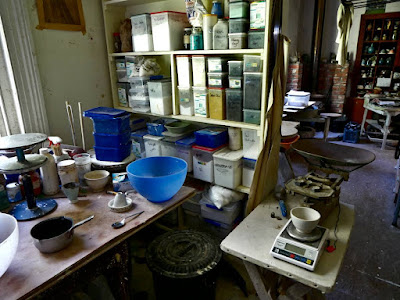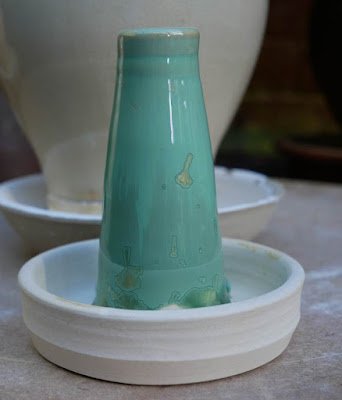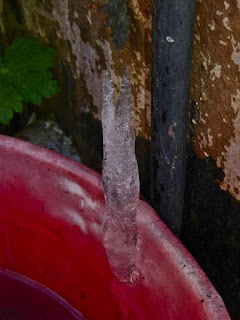A Visit from Balclutha Pottery Club, and ... a Investigating a Crime Scene in the Kiln!
 |
| A corner of my studio with some of my glaze materials. |
We had a visit last Friday from the Balclutha Pottery Club, and I had an enjoyable time answering questions about glazing and firing pots, demonstrating a few things on the potter's wheel and showing them the wood fired kiln. I haven't done much of that sort of thing for quite a while and I tend to be a little isolated out here, but it was lovely being able to have the opportunity to pass on some of what I have learned and to be in the company of other people who are enjoying working with clay. Potter's were very kind and helpful to me when I started to make pots, and I always remember that.
The Strange Case of the missing Crystals and Messed up pots!
Witness Statement....
Thurs 9 March 2023
 |
| The log of this firing. Temperature is in Celsius. |
With the assistance of our cat, Nigella Stopit, I had risen quite early and started the firing at 4.40am. It had seemed like a very good firing, the rate of temperature rise was rapid and predictable and the cones were easy to see through the spy hole. I had set cones 9 and 10, and for clarity I had not included the troublesome cone 8 that had shown a tendency to go down after cone 9 in previous firings!
 |
| Orton Cones numbered 8, 9 and 10. They measure heat work in the kiln which is a combination of time and temperature. |
I slowed the kiln as it approached peak temperature to allow any bubbles in the glaze to settle, and the kiln behaved well enough for me to later be able to do a steady hold of just over 3 hours for the crystals to grow. I was rather pleased with how it had gone and anticipated a better result than the 03 March firing where I had not controlled things so well.
 |
| A view of the kiln prior to the firing. |
There were 4 vases in the kiln and I had been able to also squeeze in two glaze testers.
 |
| Awful vases! |
When I unpacked the firing I found that all 4 vases were truly awful,
 |
| Good Testers! |
but the two glaze testers were good!
The Investigation....
Things were so bad with the glazes on the vases, that it was actually rather an interesting puzzle to sort out - more like a crime scene in a murder mystery than a little group of sad pots from a glaze firing!
The green glaze test shared the same glaze base (with a little copper added) as the white vase beside it.
The glaze on the vase was bubbled, crazed, glassy and looked badly over fired,
the glaze on the green tester had none of these faults.
 |
| Same temperature, same glaze! |
The vase on the left has the same glaze as the little tester on the right, both were fired to the same temperature, but in different firings. The glaze recipe was one that I used many times in the past with great success and it was baffling to see it looking so over fired on the vase and so altered in appearance.
The other two vases in the firing were also unattractively marred by faults and really different from the way their glazes had behaved in the 23 February test firing.
Previous Hypothesis...
The previous bad firing had me thinking that the glaze faults could have been caused by a combination of applying the glaze a little too thickly, not doing a short hold at peak temperature, and possibly allowing the temperature to get a little too high when the crystals were growing. I addressed all those problems and yet the awfulness continued, and if anything, it was even worse!
 |
| Grinding stubborn glaze ingredients with a mortar and pestle prior to sieving. |
Things in Common...
To help make sense of what had happened I had a think about what glaze ingredients each problem vase had in common.
Some glazes used a glaze frit, others used feldspar, but both types were affected.
All glazes used quartz to supply silica.
All glazes used the same zinc oxide.
Whilst it was tempting to start to blame either the zinc or the quartz, it had to be remembered that the glaze testers that I put in this firing and in the 23 February glaze test firing were really successful, and they shared exactly the same ingredients as the horrible vases!
The clay body used for the vases was the same as the one used for the successful tests.
A Glimmer of an Idea.....
It was all a bit mysterious, until I realised that the vases all had a dark iron-rich liner glaze, but the testers had no inside glaze.
I had often used a similar glaze inside crystalline vases in the past,
 |
| A vase from 2014 with an iron-rich liner glaze. |
however I had made a couple of adjustments to the glaze in recent times to make it mature at a lower temperature than it did before, and to be a little darker (I had added 2.5 percent calcium borate frit, and about 2 percent more iron oxide). Could it be that the glaze that was inside my crystalline vases was able to influence the crystalline glaze on the outside? The crystalline glazes on the outside appeared over fired and were badly bubbled, was it really possible that the inside glaze could have fluxed the outside glaze?
Interestingly, iron oxide, when heated to stoneware temperatures, gets into a rather excited party mood and lets go of some of the oxygen that is bound up with the iron.
I wonder if the iron in the glaze I had used inside the vases was able to push some oxygen through the wall of the pot and cause bubbles in the crystalline glaze?
Or was the mere fact of sealing the inside of the pot meaning that any outgassing from the clay body was going to have to make its way through the glaze, and the crystalline one was more affected by this for some reason than the inside glaze? The crystalline glaze would become molten and seal the clay at a lower temperature than the inside glaze. If the clay body was outgassing something that had not been got rid of in the bisque firing, then it may have blown bubbles into the crystalline glaze, but have passed harmlessly through the unmelted inside glaze. The firing was a very rapid one, and in spite of slowing the firing at it neared the peak temperature there may not have been enough time for the bubbles on the outside glaze to settle.
A Suspect.....
My chief suspect at this point of the investigation is the inside glaze, and I also have some questions to ask the clay body! I will have to set up a little experiment and fire the kiln again to understand this further, and perhaps discover the culprit!
I have had good success with crystalline glazes in the past and it is a little frustrating to meet with such difficulty now, but crystalline glazes are rarely easy, and if I am correct in my hunch that the inside glaze is having this effect on the outside one, then it does provide a fascinating glimpse into the world inside the kiln at very high temperature when clay and glaze dance together!





Comments
My sincere apology for accidentally deleting your post the last time I blogged! I reposted but sheesh I wish blogger would fix that!
We are thinking of you both and send lots of hugs and best wishes.
Hi Sandy,
Thank you for wading through this long blog episode and for letting me know about the trouble you had with a porcelain pot where the inside glaze affected the outer one. It was very helpful to know that such things can really happen. What really takes place with glaze materials and clay when at such high temperature is like a glimpse at life on a different planet, it is so unlike our everyday experience of the world. Crystalline glazes have made me think a lot more about what does happen in the kiln, even though my "artistic" rather than scientific mind tends process the information as pictures, rather than as equations!
Regards your accidental delete of my comment, no apology needed, I have done the same thing myself at some point. I saw that you had managed to repost it and that was much appreciated :-)